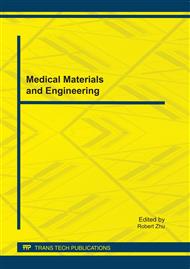p.1
p.7
p.12
p.17
p.24
p.29
p.34
p.38
An Experimental Research of Repairing Osteochondral Defect in a Rabbit Model with Tissue-Engineered Nanohydroxyapatite/Chitosan Graft
Abstract:
We repaired osteochondral defect of rabbits with tissue-engineered osteochondral graft composited by chondrocyte and nanohydroxyapatite/chitosan (nanoHA/CS) scaffold. Bone marrow mesenchymal stem cells (BMSCs) were cultivated with chondrogenic differentiation medium and induced to chondrocyte. Seed the chondrocyte into the bottom of the nanoHA/CS scaffold with a boot-shaped structure and cultivated the composite in the chondrogenic differentiation medium for 2 weeks. Osteochondral defect of 4mm in diameter and 8mm in depth were created in the epicondyle of femur. The composite graft were grafted into the defects while the composite graft induced without boot-shaped structure as the matched group. Specimens were harvested at 4th and 12th week post operation respectively, general and histological examination was performed and graded. We found BMSCs were induced to chondrocyte after cultivated with chondrogenic differentiation medium. The interstice ratio and diameter of nanoHA/CS scaffold is 90% and 150μm. The scaffold has good adhesion with chondrocyte. The coupling between the bone and the cartilage in the experimental group is superior to the matched group obviously. This results indicate that tissue-engineered osteochondral graft composited by boot-shaped structure can be a new approach to attempt to overcome the technical surgical difficulties identified in this study.
Info:
Periodical:
Pages:
17-23
Citation:
Online since:
November 2011
Price:
Сopyright:
© 2012 Trans Tech Publications Ltd. All Rights Reserved
Share:
Citation:


